ChatGPT is a generative Artificial Intelligence (AI) technology pioneered by OpenAI, which is a Large Language Model trained on billions of text data from various sources, mostly from the open internet. ChatGPT can undertake any task that involves understanding or generating natural language, software code snippets, or images based on certain text inputs. The power of ChatGPT lies in content creation, semantic search, and classification.
ChatGPT offers a plethora of capabilities for technical writers to undertake their day-to-day activities more effectively. Technical writers can utilize the power of ChatGPT technology across the Documentation Development Life Cycle (DDLC) from planning to archival. This blog covers the aspects of how technical writers can utilize ChatGPT for software documentation.
How to utilize ChatGPT for software documentation lifecycle?
After the introduction of ChatGPT 4, the technical writers’ community is excited about how the technology will shape the roles and responsibilities of a technical writer. There are numerous ways a technical writer can tap into Generative AI technologies to undertake certain activities quickly and achieve business outcomes effectively across the software documentation lifecycle.
They are as follows,
-
- Content creation
- Content enrichment
- Customer feedback compilation
- Product blogs
Content Creation
As a technical writer, most of the time is spent in getting a session with developers or product managers about upcoming product features. After the Knowledge Transfer (KT) session, the technical writers spend time designing the content, which involves
-
- Designing content structure
- Generating support artifact
- Generating an outline for each content topic
- Creating content flow
- Understanding the business glossary
These tasks consume a technical writer’s time and can be automated with ChatGPT to get started. ChatGPT can produce an article outline along with suggested content and can provide a good content structure to start with if a technical writer can provide an accurate prompt to ChatGPT.
For example, if you provide a prompt such as “Document360 is a knowledge base platform that helps SaaS companies create interactive software documentation for their customers. Zapier is a work automation engine that can automate workflows. Generate an article outline hereby Document360 integrates with Zapier”. This prompt generates an article outline with the right content structure H1 – H6 (Headings) with proper communication flow. The ChatGPT prompt can be tweaked such that ChatGPT adds sample content/snippets to each section.

The content produced by ChatGPT will mostly be free from grammatical errors and spelling mistakes. The logical content flow already exists in the article content. Thus, technical writers’ efforts will be predominantly on adding more value-added content that is very specific to a particular software product. Annotation of images and other media artifacts can also be associated using ChatGPT.
Given that ChatGPT is trained on billions of text data, it is equipped to provide an outline, and contents in paragraphs for most of the topics/themes. Technical writers shall tweak appropriate business terms based on the corporate business glossary in the article content. Thus, ChatGPT can help technical writers focus on high-value content creation tasks rather than doing mundane work. The technical writer can focus on business outcomes by reducing “Time-to-value” to get the software documentation more quickly. Thus, ChatGPT can produce quick software feature documentation.
Also Read: The Future of Knowledge Base in the Age of Generative AI
Schedule a demo with one of our experts to take a deeper dive into Document360
Book A Demo
Content Enrichment
Since most of the grunt work has already been done by ChatGPT in terms of producing content outlines and sample content, the next focus task is the enrichment of the drafted content copy.

Content enrichment involves the following activities
-
- Peer-review and feedback: Once a draft content is enriched by a technical writer, it is sent for peer review. These peer-reviews can be compiled and can be given as prompt to enrich the article content
-
- Editorial review and comments: Editorial comments can be addressed easily by ChatGPT as it needs to change a tone, comply with inclusive language principles, and accessibility
-
- SEO-based feedback from the marketing team: ChatGPT can suggest the optimal article title, meta description, and keyword density required for a knowledge base article to rank in search engine result with less or no manual effort from a technical writer
Besides this, if a SaaS software company has released a feature enhancement, then respective documentation can be enriched by ChatGPT in the following steps
-
- Feed in the existing product feature documentation to ChatGPT via prompt / API
- Explain to ChatGPT
-
-
- Why was this product feature enhanced?
- What changes have been made to the UX?
- How will this change improve business value?
- What impact will the user observe because of this product feature enhancement?
- Then ask ChatGPT to produce a documentation draft for this feature enhancement
-
Customer Feedback Compilation
If a specific article has received a huge volume of feedback, it is impossible for a technical writer to go through each of those them and then understand what customers are saying. ChatGPT can ingest a huge volume of customer feedback and can
-
- Categorize them into different themes for technical writers to understand
- Compile all feedback themes and summarize action items for technical writers to focus on
- Provide revised content based on the customers’ feedback
If technical writers can compile a huge volume of customer feedback and share it with ChatGPT, it can synthesize and facilitate the outcomes. Technical writers can seek assistance from ChatGPT when the volume of feedback is huge and need to synthesize content efficiently.
Product Blogs
ChatGPT offers a service to fine-tune their generic Large Language Model using enough samples of prompts combined with just a few examples. Once ChatGPT has been fine-tuned to your product, ChatGPT can be requested to produce a product blog on new features, feature enhancements, and bug fixes. With the draft done in no time, technical writers can then enrich the blog content with their product knowledge and other customer feedback. Then the content gets reviewed by an Editor for quality assurance before being handed over to the marketing team. The marketing team can then publish SEO-optimized product blogs with a shorter turnaround time, accelerating traffic generation for their product pages. This leads to a shorter sales cycle, thus increasing the company’s revenue.
New skills for a technical writer
Technical writers need to learn skills to interact with Generative AI technology, such as
Prompt Engineering
This involves asking the right questions to ChatGPT to get the desired outcomes. This could be as simple as generating an outline for an article to complex tasks such as undertaking text analysis
Writing for Generative AI models
If software documentation produced by technical writers is considered for training a Generative AI model such as ChatGPT, then content shall be structured and produced in a machine-friendly way. Technical writers need to understand how to produce AI-friendly content
Text Analytics
Understand how to ask the right analytical questions based on textual data. This includes asking questions to gauge the sentiment of customer feedback, summary all customer feedback, understating the tone of an article, and so on
Also Read: Top 20 Software Documentation Tools
Watch this video to see our product in action and learn how it can streamline your software documentation workflow
Wrapping Up
Technical writers shall embrace ChatGPT technology and leverage its capabilities to their advantage in producing software documentation. ChatGPT can assist technical writers in performing their assigned responsibility more quickly and accurately. ChatGPT can offer help across the documentation lifecycle, and ease of use will make it more prevalent amongst the technical writers’ community.
Rather than being apprehensive about Generative AI being able to replace human technical writers, it is inevitable that technical documentation needs human intervention as our primary audience is a human at least at the current time. In the future, technical writers might produce content predominantly for Generative AI/bots and other technologies. That’ll be a topic for another post!




 –
– 

